Julian Ashby Burruss, 1908-1919
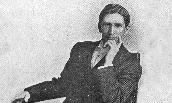 Julian Ashby Burruss was named president of the State Normal and Industrial School for Women at Harrisonburg in 1908. Shortly after the institution was founded by the Virginia General Assembly, the school opened its doors to its first student body in 1909 with an enrollment of 209 students and 15 faculty members. The first 20 graduates received diplomas in 1911. President Burruss’ administration changed the name of the school to the State Normal School for Women at Harrisonburg in 1914, and the school received authorization to award bachelor’s degrees in 1916. During this initial development of James Madison University, President Burruss established the campus plan and oversaw the construction of six buildings. He left the Normal School in 1919 to become president of Virginia Tech.
Julian Ashby Burruss was named president of the State Normal and Industrial School for Women at Harrisonburg in 1908. Shortly after the institution was founded by the Virginia General Assembly, the school opened its doors to its first student body in 1909 with an enrollment of 209 students and 15 faculty members. The first 20 graduates received diplomas in 1911. President Burruss’ administration changed the name of the school to the State Normal School for Women at Harrisonburg in 1914, and the school received authorization to award bachelor’s degrees in 1916. During this initial development of James Madison University, President Burruss established the campus plan and oversaw the construction of six buildings. He left the Normal School in 1919 to become president of Virginia Tech.
Dr. Samuel Page Duke, 1919-1949
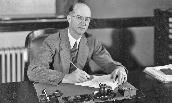 During the 30 years of Dr. Samuel Page Duke’s presidency, enrollment at the institution grew from 300 to around 1,400. Nine major campus buildings were constructed during his administration. In 1924, the institution became the State Teachers College at Harrisonburg and continued under than name until 1938, when it was named Madison College in honor of James Madison, the fourth president of the United States. In making his argument for the name change, President Duke pointed out that no other college honored Mr. Madison, and the name would be appropriate if the institution ever became coeducational. In 1946, Dr. Duke’s administration admitted men to Madison College as day students in regular sessions. Men had always attended summer sessions at the school, but this marked the first time men attended regular session classes.
During the 30 years of Dr. Samuel Page Duke’s presidency, enrollment at the institution grew from 300 to around 1,400. Nine major campus buildings were constructed during his administration. In 1924, the institution became the State Teachers College at Harrisonburg and continued under than name until 1938, when it was named Madison College in honor of James Madison, the fourth president of the United States. In making his argument for the name change, President Duke pointed out that no other college honored Mr. Madison, and the name would be appropriate if the institution ever became coeducational. In 1946, Dr. Duke’s administration admitted men to Madison College as day students in regular sessions. Men had always attended summer sessions at the school, but this marked the first time men attended regular session classes.
Dr. G. Tyler Miller, 1949-1971
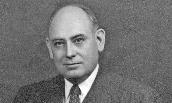 President G. Tyler Miller successfully convinced the Virginia General Assembly in 1966 to allow Madison College to build residence halls for men so the institution could become fully coeducational. He had first expressed the wish for Madison to become coeducational in the early 1950s but was unsuccessful in that effort. Dr. Miller enlarged the institution’s campus by 240 acres and constructed 19 major buildings. The Miller administration revamped the institution’s curriculum, developing a full liberal arts program to join the teacher education program. In 1954, the expanding school received authorization to award master’s degrees. During Dr. Miller’s presidency enrollment grew from 1,400 to 4,000.
President G. Tyler Miller successfully convinced the Virginia General Assembly in 1966 to allow Madison College to build residence halls for men so the institution could become fully coeducational. He had first expressed the wish for Madison to become coeducational in the early 1950s but was unsuccessful in that effort. Dr. Miller enlarged the institution’s campus by 240 acres and constructed 19 major buildings. The Miller administration revamped the institution’s curriculum, developing a full liberal arts program to join the teacher education program. In 1954, the expanding school received authorization to award master’s degrees. During Dr. Miller’s presidency enrollment grew from 1,400 to 4,000.
Dr. Ronald E. Carrier, 1971-1998
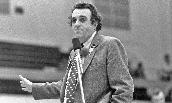 During the presidency of Dr. Ronald E. Carrier, the institution changed from a 4,000-student, predominantly female teachers college to a major comprehensive university with 14,000 students. The school changed its name to James Madison University in 1977, following a unanimous vote of the Virginia General Assembly. During Dr. Carrier’s presidency, JMU received national acclaim as one of the nation’s finest comprehensive public universities. The institution received authorization to offer the educational specialist degree and the doctorial degree. A major athletics program was developed. The size of the campus was enlarged by more than 100 acres, and the university spread to the east side of Interstate 81. During Dr. Carrier’s administration, some 40 major buildings with a value of $210 million were built. Applications for admission rose from 3,800 a year to 15,000 a year, and median SAT scores for freshman rose from 987 to 1174.
During the presidency of Dr. Ronald E. Carrier, the institution changed from a 4,000-student, predominantly female teachers college to a major comprehensive university with 14,000 students. The school changed its name to James Madison University in 1977, following a unanimous vote of the Virginia General Assembly. During Dr. Carrier’s presidency, JMU received national acclaim as one of the nation’s finest comprehensive public universities. The institution received authorization to offer the educational specialist degree and the doctorial degree. A major athletics program was developed. The size of the campus was enlarged by more than 100 acres, and the university spread to the east side of Interstate 81. During Dr. Carrier’s administration, some 40 major buildings with a value of $210 million were built. Applications for admission rose from 3,800 a year to 15,000 a year, and median SAT scores for freshman rose from 987 to 1174.
Dr. Linwood H. Rose, 1998-2012
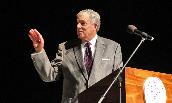 Dr. Linwood H. Rose led James Madison University to establish the standard for a new kind of American university — one that merges the best qualities of the small liberal arts college with the opportunities of a large research university. Rose championed academic programs that provide hands-on learning and also benefit the public good. He emphasized the sciences and the arts, including developing a new engineering program focused on design and sustainability and opening the Forbes Center for the Performing Arts. Under Rose, JMU became a leader in institutional performance measurement, accountability and assessment of student learning, and established a Phi Beta Kappa chapter on campus. During a period of growth that saw enrollment reach nearly 20,000 and the number of graduate and doctoral programs double, the student-to-faculty ratio decreased from 19.2:1 to 16:1. And quality, student success and teaching remained preeminent.
Dr. Linwood H. Rose led James Madison University to establish the standard for a new kind of American university — one that merges the best qualities of the small liberal arts college with the opportunities of a large research university. Rose championed academic programs that provide hands-on learning and also benefit the public good. He emphasized the sciences and the arts, including developing a new engineering program focused on design and sustainability and opening the Forbes Center for the Performing Arts. Under Rose, JMU became a leader in institutional performance measurement, accountability and assessment of student learning, and established a Phi Beta Kappa chapter on campus. During a period of growth that saw enrollment reach nearly 20,000 and the number of graduate and doctoral programs double, the student-to-faculty ratio decreased from 19.2:1 to 16:1. And quality, student success and teaching remained preeminent.
